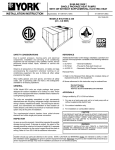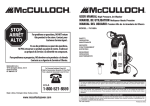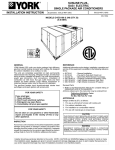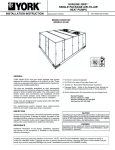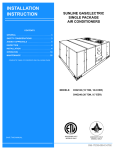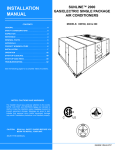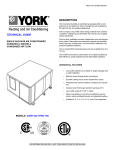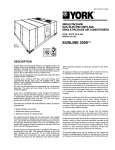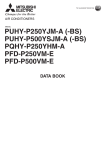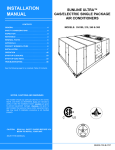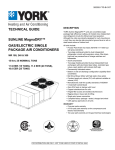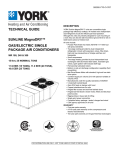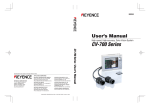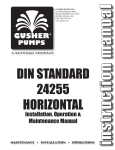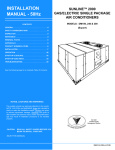Download York SUNLINE 2000 B2CH180 Specifications
Transcript
® INSTALLATION INSTRUCTION SUNLINE 2000 SINGLE PACKAGE HEAT PUMPS WITH OR WITHOUT SUPPLEMENTAL ELECTRIC HEAT 035-18894-000-A-0702 Supersedes: Nothing MODELS B2CH180 (9.9 EER) 208/230/460 VOLT MODELS ONLY 208/230/575 VOLT MODELS ONLY SAFETY CONSIDERATIONS REFERENCE Due to system pressure, moving parts and electrical components, installation and servicing of air conditioning equipment can be hazardous. Only qualified, trained, service personnel should install, repair, maintain or service this equipment. Additional information on the design, installation, operation and service of this equipment is available in the following reference forms: Observe all precautions in the literature, on labels and tags accompanying the equipment whenever working on air conditioning equipment. Be sure to follow all other safety precautions that apply. Wear safety glasses and work gloves, and follow all safety codes. Use a quenching cloth and have a fire extinguisher available for all brazing operations. GENERAL YORK Model BCH units are single package heat pumps designed for outdoor installation on a rooftop or a slab. These units can be equipped with factory installed electric heaters for cooling/heating applications. • 55.70-N1 • 55.70-N2 • 44-320-10 - General Installation - Pre-start & Post-start Check List - Barometric Relief Damper Accessory Renewal Parts: • Refer to the Renewal Parts Manual for complete listing of replacement parts on this equipment. All forms referenced in this instruction may be ordered from: Standard Register Norman, OK 73069 Toll Free: Tel. 877-318-9675/Fax. 877-379-7920 APPROVALS Design certified by ETL & CGA as follows: The units are completely assembled on rigid, permanently attached base rails. All piping, refrigerant charge, and electrical wiring is factory installed and tested. The units require electric power, duct connections and installation of fixed outdoor air intake damper (units without economizer or motorized damper option only) at the point of installation. The supplemental electric heaters have nickel-chrome elements and utilize single point power connection. INSPECTION As soon as a unit is received, it should be inspected for possible damage during transit. If damage is evident, the extent of the damage should be noted on the carrier's freight bill. A separate request for inspection by the carrier's agent should be made in writing. Refer to Form 50.15-NM for additional information. 1. For use as a heat pump only unit or a heat pump with or without supplemental electric heat. 2. For outdoor installation only. 3. For installation on combustible material. CAUTION T H I S P R O D U C T M U S T B E I N S TA L L E D I N S T R I C T COMPLIANCE WITH THE ENCLOSED INSTALLATION INSTRUCTIONS AND ANY APPLICABLE LOCAL, STATE, AND NATIONAL CODES INDLUCING, BUT NOT LIMITED TO, BUILDING, ELECTRICAL, AND MECHANICAL CODES. WARNING INCORRECT INSTALLATION MAY CREATE A CONDITION WHERE THE OPERATION OF THE PRODUCT COULD CAUSE PERSONAL INJURY OR PROPERTY DAMAGE. Installer should pay particular attention to the words: NOTE, CAUTION and WARNING. Notes are intended to clarify or make the installation easier. Cautions are given to prevent equipment damage. Warnings are given to alert installer that personal injury and/or equipment damage may result if installation procedure is not handled properly. 035-18894-000-A-0702 TABLE OF CONTENTS General................................................................................1 Inspection ............................................................................1 Reference ............................................................................1 Approvals ............................................................................1 Nomenclature ......................................................................2 MAINTENANCE Normal Maintenance .........................................................17 TABLES No. 1 2 3 4 5 6 7 8 9 10 11 12 INSTALLATION Limitations ...........................................................................3 Location ...............................................................................3 Rigging and Handling ..........................................................3 Clearances ..........................................................................3 Ductwork .............................................................................3 Fixed Outdoor Air Intake Damper........................................4 Condensate Drain ...............................................................4 Compressors .......................................................................4 Filters...................................................................................4 Service Access ....................................................................4 Thermostat ..........................................................................4 Power and Control Wiring ...................................................4 Optional Electric Heaters.....................................................5 Optional Economizer/Mot. Damper Rain Hood ...................5 Optional Power Exhaust Rain Hood ....................................7 Description Page Unit Application Data.................................. 3 Control Wire Sizes ..................................... 5 Electric Heat Application Data.................... 5 Physical Data ............................................. 8 Four and Six Point Loads........................... 10 Supply Air Blower Perf. 15 Ton .................. 11 Static Resistances...................................... 12 Power Exhaust Performance ..................... 12 Blower Motor and Drive Data ..................... 12 Electrical Data (Basic Units)....................... 13 Electrical Data (Units w/Elec. Heat) ........... 13 Heat Anticipator Setpoints.......................... 15 FIGURES No. 1 2 3 4 5 6 7 8 9 10 11 12 OPERATION Cooling System .................................................................14 Preliminary Operation Cooling ..........................................14 Cooling Sequence of Operation ........................................14 Heating Sequence of Operation ........................................14 Heat Anticipator Setpoints .................................................15 Checking Supply Air CFM .................................................15 Defrost Sequence of Operation .........................................16 Secure Owner's Approval..................................................17 Description Page Typical Rigging........................................... 3 Center of Gravity ........................................ 3 Fixed Outdoor Air Damper ......................... 4 Recommended Drain Piping ...................... 4 Typical Field Wiring .................................... 5 Adjusting Enthalpy Setpoint ....................... 7 Dimensions and Clearances ...................... 9 Four and Six Point Loads........................... 10 Belt Adjustment .......................................... 15 Pressure Drop versus Supply Air CFM ...... 15 Defrost Initiation Times .............................. 16 Ambient Modified Time/Temp. Control ....... 17 PRODUCT NOMENCLATURE B 2 C H 1 8 0 E 0 1 8 2 5 PRODUCT CATEGORY B = Single Package Heat Pump (Air Cooled) PRODUCT GENERATION 2 = 2nd Generation NOMINAL HEATING CAPACITY PRODUCT IDENTIFIER 018 = 18 KW 036 = 36 KW 054 = 54 KW 072 = 72 KW CH = Heat Pump NOMINAL COOLING CAPACITY 180 = 15 Tons 2 FACTORY INSTALLED HEAT E C FACTORY INSTALLED OPTION CODE EC = Sing. Input Economizer DK = Diff. Input Economizer FD = Sing. Input Economizer w/Power Exhaust CF = Diff. Input Economizer w/Power Exhaust BG = Motor Outdoor Air Damper VOLTAGE CODE 25 = 208/230-3-60 46 = 460-3-60 58 = 575-3-60 A = No Heat E = Electric Unitary Products Group 035-18894-000-A-0702 INSTALLATION LIMITATIONS These units must be installed in accordance with the following national and local safety codes: In U.S.A.: 1. National Electrical Code ANSI/NFPA No. 70. 2. Local electric utility requirements. In Canada: 1. Current Canadian Electrical Code CSA C22.1. 2. Local electrical codes. Refer to the Unit Application Data and to Table 3 for Electric Heat Application Data table. If components are to be added to a unit to meet local codes, they are to be installed at the dealer's and/or the customer's expense. Size of unit for proposed installation should be based on heat loss/heat gain calculation made according to the methods of the Air Conditioning Contractors of America (ACCA). TABLE 1 - UNIT APPLICATION DATA Model Size 208/230-3-60 Voltage Variation, 460-3-60 Min. / Max.1 575-3-60 Supply Air CFM, Min. / Max. Wet Bulb Temperature (°F) of Air on Indoor Coil Min. / Max. Dry Bulb Temperature (°F) of Air on Outdoor Coil Min. / Max. 15 TON 187 / 253 414 / 506 518 / 630 45002 / 7200 FIG. 1 - TYPICAL RIGGING Units may also be moved or lifted with a forklift, from the front or rear only, providing that an accessory skid is used. LENGTH OF FORKS MUST BE A MINIMUM OF 90". Refer to the Physical Data table for unit weights and to the figure below for approximate center of gravity. OUTDOOR COIL END 57 / 72 45 / 120 1 Rated in accordance with ARI Standard 110, utilization range “A”. 2 5,000 CFM on 15 ton models with either a 54 or 72 KW heater at 208/230 volts. LOCATION FIG. 2 - CENTER OF GRAVITY Use the following guidelines to select a suitable location for these units. 1. Unit is designed for outdoor installation only. 2. Outdoor coils must have an unlimited supply of air. Where a choice of location is possible, position the unit on either north or east side of building. 3. For ground level installation, use a level concrete slab with a minimum thickness of 4 inches. The length and width should be at least 6 inches greater than the unit base rail dimensions. Do not tie slab to the building foundation. 4. Roof structures must be able to support the weight of the unit and its options and/or accessories. Unit must be installed on a solid level roof curb or appropriate angle iron frame. CLEARANCES CAUTION: If a unit is to be installed on a roof curb or special frame other than a YORK roof curb, gasketing must be applied to all surfaces that come in contact with the unit underside. 5. Maintain level tolerance to 1/2" maximum across the entire length or width of the unit. RIGGING AND HANDLING Exercise care when moving the unit. Do not remove any packaging until the unit is near the place of installation. Rig the unit by attaching chain or cable slings to the round lifting holes provided in the base rails. Spreaders, whose length exceeds the larger dimension across the unit, MUST be used across the top of the unit. Refer to the Typical Rigging Figure. Unitary Products Group All units require certain clearances for proper operation and service. Refer to the Dimensions and Clearances Figure 7 for the clearances required for combustible construction, servicing, and proper unit operation. WARNING: Do not permit overhanging structures or shrubs to obstruct outdoor air discharge outlet. DUCTWORK Ductwork should be designed and sized according to the methods in Manual Q of the Air Conditioning Contractors of America (ACCA). A closed return duct system shall be used. This shall not preclude use of economizers or outdoor fresh air intake. The supply and return air duct connections at the unit should be made with flexible joints to minimize transmission of noise. The supply and return air duct systems should be designed for the CFM and static requirements of the job. They should NOT be sized to match the dimensions of the duct connections on the unit. CAUTION: When fastening ductwork to side duct flanges on the unit, insert screws through duct flanges only. DO NOT insert screws through casing. Outdoor ductwork must be insulated and waterproofed. Refer to the Dimensions and Clearances Figure for information concerning side and bottom supply and return air duct openings. 3 035-18894-000-A-0702 FIXED OUTDOOR AIR INTAKE DAMPER This damper is shipped inside the return air compartment. It is completely assembled and ready for installation. A damper baffle inside the hood is adjustable to provide variable amounts of outdoor air intake on units that are not provided with an economizer or a motorized damper option. Gasketing and mounting screws are provided in a parts bag attached to the hood assembly. Apply gasketing to the three flange surfaces on the hood prior to installing the hood. Extend gasketing 1/4" beyond the top and bottom of the two side flanges to insure adequate sealing. Adjusting the damper to the desired air flow may be done before mounting the hood into position or (after installation) by removing the front hood panel or the screen on the bottom of the hood. Damper baffle in position 1 will allow approximately 10% recirculated air flow, position 2 approximately 15% and, to allow approximately 25%, remove the damper baffle. On units with bottom return air applications, install the damper assembly over the opening in the side return air access panel. Remove and discard the opening cover and the covering over the hood mounting holes (used for shipping) before installing. Secure with the screws provided. On units with side return air applications, install the damper assembly on the return air ductwork as close to the unit as possible. Cut an opening 16" high by 18" wide in the ductwork to accommodate the damper. Using the holes in the hood flanges as a template, drill 9/64" dia. (#26 drill) holes into the ductwork and secure with the screws provided. CAUTION: If outdoor air intake will not be required on units with bottom return air applications, the damper assembly should still be mounted on the side return air access panel, per the instructions above, to insure moisture is not drawn into the unit during operation. The covering over the mounting holes only need be removed. Do not remove the opening cover. FIG. 4 - RECOMMENDED DRAIN PIPING COMPRESSORS Units are shipped with compressor mountings factory-adjusted and ready for operation. CAUTION: Do Not loosen compressor mounting bolts. FILTERS 2" filters are supplied with each unit. Filters must always be installed ahead of the indoor coil and must be kept clean or replaced with same size and type. Dirty filters will reduce the capacity of the unit and will result in frosted coils or safety shutdown. Minimum filter area and required sizes are shown in the Physical Data table. SERVICE ACCESS Access to all serviceable components is provided by the following removable panels: • • • • • • • Compressor compartment Electric Heat compartment Side Supply & Return Air compartments (Two panels) Blower compartment (Three panels) Main control box Filter compartment Outdoor Air compartment (Two panels) Refer to Dimensions and Clearances Figure 7 for location of these access panels. CAUTION: Make sure that all screws and panel latches are replaced and properly positioned on the unit to maintain an air-tight seal. THERMOSTAT FIG. 3 - FIXED OUTDOOR AIR DAMPER CONDENSATE DRAIN Plumbing must conform to local codes. Use a sealing compound on male pipe threads. Install a condensate drain line from the 1" NPT female connection on the unit to an open drain. An alternate drain connection (1" NPT female coupling) is provided inboard on the same centerline as the exterior location. NOTE: The condensate drain operates in a negative pressure in the cabinet. The condensate drain line MUST be trapped to provide proper drainage. 4 The room thermostat should be located on an inside wall approximately 56" above the floor where it will not be subject to drafts, sun exposure or heat from electrical fixtures or appliances. Follow manufacturer's instructions enclosed with thermostat for general installation procedure. Color coded insulated wires (#18 AWG) should be used to connect thermostat to unit. Eight conductors are required. The subbase on the low voltage thermostat includes an “Emergency Heat” position on the system switch and a pilot light. In the “Emergency Heat” position, the thermostat will provide electric resistance heat only. The compressors will not run. The pilot light will indicate that the switch is on “EM HT”. Nine conductors are required for this application. POWER AND CONTROL WIRING Field wiring to the unit must conform to provisions of the National Electrical Code, ANSI / NFPA No. 70 (in U.S.A.), current Canadian Electric Code (CEC) CSA C22.1 (in Canada) and/or local ordinances. The unit must be electrically grounded in accordance with NEC and CEC (as specified above) and/or local codes. Voltage tolerances which must be maintained at the compressor terminals during starting and running conditions are indicated on the unit Rating Plate. Unitary Products Group 035-18894-000-A-0702 FIG. 5 - TYPICAL FIELD WIRING The internal wiring harness furnished with this unit is an integral part of a ETL and CGA design certified unit. Field alteration to comply with electrical codes should not be required. A fused disconnect switch should be field provided for the unit. The switch must be separate from all other circuits. Wire entry at knockout openings require conduit fittings to comply with CEC (in Canada), NEC (in U.S.A.) and/or local codes. Refer to the Dimensions and Clearances Figure for installation location. If any of the wire supplied with the unit must be replaced, replacement wire must be of the type shown on the wiring diagram and the same minimum gauge as the replaced wire. Electrical line must be sized properly to carry the load. Each unit must be wired with a separate branch circuit fed directly from the meter panel and properly fused. CAUTION: When connecting electrical power and control wiring to the unit, waterproof type connectors MUST BE USED so that water or moisture cannot be drawn into the unit during normal operation. The above waterproofing conditions will also apply when installing a field-supplied disconnect switch. TABLE 2 - CONTROL WIRE SIZES Wire Size1 AWG. Gauge 22 20 19 18 16 40 120 150 190 305 Maximum Wire Length2 Feet Notes: 1. Solid, Class II copper wire 2. Based on a voltage drop of 1.2 volts per wire. 3. Total wire length is from unit to room thermostat, and back to unit Unitary Products Group 5 035-18894-000-A-0702 Refer to the Typical Field Wiring Figure 5 and to the appropriate unit wiring diagram for control circuit and power wiring information. baffles, and all the control sensors are factory mounted as part of the “Factory installed” economizer option. ENTHALPY SET POINT ADJUSTMENT OPTIONAL ELECTRIC HEATERS The factory installed heaters are wired for single point power supply. Power supply need only be brought into the single point terminal block and thermostat wiring to the low voltage terminal strip located in the upper portion of the unit control box. These ETL and CGA approved heaters are located within the central compartment of the unit with the heater elements extending into the supply air chamber. Refer to the Dimensions and Clearances Figure for access panel location. TABLE 3 - ELECTRIC HEAT APPLICATION DATA NOMINAL HEATER SIZE (KW) 18 36 54 72 VOLTAGE 3 PHASE, 60 HZ 208/230,460,575 208/230,460,575 208/230 460, 575 208/230 460, 575 MINIMUM CFM (UNIT SIZE) 15 TON 4500 4500 5000 4500 5000 4500 Fuses are supplied, where required, by the factory. Some KW sizes require fuses and others do not. Refer to the Electric Heat Application table for minimum CFM limitations and to the Electrical Data table for electrical data. OPTIONAL ECONOMIZER/MOTORIZED DAMPER RAIN HOOD The instruction for the optional economizer/motorized damper rain hood can be found in form 44-320-2. Use these instructions when field assembling an economizer rain hood onto a unit. The outdoor and return air dampers, the damper actuator, the damper linkage, the outdoor and return air divider Remove the economizer access panel from the unit to check the following adjustments. Loosen but do not remove the two panel latches. CAUTION: Extreme care must be exercised in turning both the setpoint and minimum position adjusting screws to prevent twisting them off. 1. The enthalpy set point may now be set by selecting the desired setpoint shown in the Adjusting Enthalpy Setpoint Figure. Adjust as follows: • For a single enthalpy operation, carefully turn the set point adjusting screw to the “A”, “B”, “C” or “D” setting corresponding to the lettered curve. • For a dual enthalpy operation, carefully turn the set point adjusting screw fully clockwise past the “D” setting. 2. To check that the damper blades move smoothly without binding, carefully turn the minimum position adjusting screw fully clockwise and then energize and de-energize terminals “R” to “G”. With terminals “R” to “G” energized, turn the minimum position screw counterclockwise until the desired minimum position has been attained. 3. Replace the economizer access panel. Reposition the two latches horizontally and retighten the screws. POWER EXHAUST/BAROMETRIC RELIEF DAMPER AND RAIN HOOD OPTION The instructions for the power exhaust/barometric relief damper and rain hood can be found in form 44-320-10. The exhaust fan, all supporting brackets, angles, and the wiring are factory installed as part of the power exhaust option. All of the components, including the dampers, hardware, and mounting instructions are shipped in a single package external from the unit. The hood must be field assembled and installed. Power exhaust is not available as a field installed option. 6 Unitary Products Group 035-18894-000-A-0702 FIG. 6 - ENTHALPY SETPOINT ADJUSTMENT Unitary Products Group 7 035-18894-000-A-0702 TABLE 4 - PHYSICAL DATA MODELS SUPPLY AIR BLOWER INDOOR COIL OUTDOOR FANS (Two Per Unit) OUTDOOR COILS COMPRESSOR (Qty. Per Unit) AIR FILTERS CHARGE 8 CENTRIFUGAL BLOWER (Dia. x Wd. in.) FAN MOTOR HP ROWS DEEP FINS PER INCH FACE AREA (Sq. Ft.) PROPELLER DIA. (in.) (Each) FAN MOTOR HP (Each) NOM. CFM TOTAL (Each) ROWS DEEP FINS PER INCH FACE AREA (Sq. Ft.) 7-1/2 TON SCROLL QUANTITY PER UNIT (16" X 20" X 2") QUANTITY PER UNIT (16" X 25" X 2") QUANTITY PER UNIT (18" X 24" X 2") TOTAL FACE AREA (sq. ft.) REFRIGERANT 22 SYSTEM NO. 1 (lbs./oz.) SYSTEM NO. 2 UNIT SIZE 15 TON 15 x 15 5 4 13 15.5 30 1 6500 3 15 36.0 OPERATING WEIGHTS (LBS.) Basic Unit Heat Pump Economizer Economizer with Power Exhaust Motorized Damper Options 18 KW 36 KW Electric Heat (Nominal KW) 54 KW 72 KW Roof Curb Accessories Barometric Damper Wood Skid 15 TON 1900 160 245 150 25 30 35 40 175 45 200 2 5 15.0 22.8 22.8 Unitary Products Group 035-18894-000-A-0702 RETURN AIR SUPPLY AIR OUTDOOR AIR OUTDOOR AIR (Economizer) All dimensions are in inches. They are subject to change without notice. Certified dimensions will be provided upon request. UTILITIES ENTRY DATA HOLE A B OPENING SIZE (DIA.) 1-1/8" KO 3/4" NPS (Fem.) 3-5/8" KO 3" NPS (Fem.) USED FOR Control Wiring Power Wiring Front Bottom Front Bottom DUCT COVERS - Units are shipped with the bottom duct openings covered. An accessory flange kit is available for connecting side ducts. For bottom duct applications: 1. Remove the side panels from the supply and return air compartments to gain access to the bottom supply and return air duct covers. 2. Remove and discard the bottom duct covers. (Duct openings are closed with sheet metal covers except when the unit includes a power exhaust option. The covering consists of a heavy black paper composition.) 3. Replace the side supply and return air compartment panels. For side duct applications; 1. Replace the side panels on the supply and return air compartments with the accessory flange kit panels. 2. Connect ductwork to the duct flanges on the rear of the unit. CLEARANCES OUTDOOR SECTION Front INDOOR SECTION Back Left Side (Filter Access) Right Side (Cond. Coil) Below Unit1 Above Unit2 36" 24" (Less Economizer) 49" (With Economizer) 24" (Less Economizer) 36"3 (With Economizer)4 36" 20" 72" With 36" Maximum Horizontal Overhang (For Outdoor Air Discharge Outlet) NOTE: Unit and ductwork are approved for zero clearance to combustible materials when equipped with electric heat. 1 Units (applicable in U.S.A. only) may be installed on combustible floors made from wood or class A, B or C roof covering material. Units must be installed outdoors. Overhanging structures or shrubs should not obstruct outdoor air discharge outlet. 3 If economizer is factory installed, the assembled hood kit must be removed prior to final installation. This hood is 54" long. 4 Remove hood kit prior to final installation. 2 DETAIL “X” (ACCESSORY SIDE SUPPLY AND RETURN AIR OPENINGS) FIG. 7 - DIMENSIONS & CLEARANCES - 15 TON Unitary Products Group 9 035-18894-000-A-0702 B F E C A D A FRONT C FRONT D 4 POINT LOADS B 6 POINT LOADS FIG. 8- FOUR AND SIX POINT LOADS TABLE 5 - FOUR AND SIX POINT LOADS UNIT TOTAL 2,090 180 A 513 4 - POINT LOADS (LBS) B 510 C 558 D 559 NOTE: These weights are with economizer and 36kW electric heat. UNIT 180 TOTAL 2,190 A 342 B 358 6 - POINT LOADS (LBS) C D 357 372 E 356 F 341 NOTE: These weights are with economizer and 36kW electric heat. 10 Unitary Products Group 035-18894-000-A-0702 TABLE 6 - SUPPLY AIR BLOWER PERFORMANCE (15 TON) 180 MBH - BOTTOM DUCT CONNECTIONS BLOWER SPEED, (RPM) MOTOR PULLEY (TURNS OPEN)* 4500 ESP BHP CFM 6000 5250 6750 7200 KW ESP BHP KW ESP BHP KW ESP BHP KW ESP BHP KW 2.2 2.3 2.4 2.6 2.7 2.8 2.9 0.7 0.8 0.9 1.0 1.1 1.2 1.3 3.0 3.1 3.4 3.6 3.7 3.8 3.9 2.7 2.8 3.0 3.2 3.3 3.4 3.5 0.5 0.6 0.7 0.8 0.9 1.0 1.1 3.2 3.5 3.7 4.0 4.1 4.2 4.5 2.9 3.1 3.3 3.6 3.7 3.8 4.0 0.2 0.3 0.5 0.6 0.7 0.9 4.1 4.4 4.7 4.8 5.0 5.2 3.7 3.9 4.2 4.3 4.5 4.7 0.2 0.4 0.5 0.6 0.7 4.5 4.9 5.1 5.4 5.7 4.0 4.4 4.6 4.8 5.1 208 VOLT AND STANDARD DRIVE 850 870 915 965 980 1010 1040 6.0** 5.5 4.5 3.5 3.0 2.0 1.0 0.9 1.0 1.1 1.2 1.3 1.4 1.5 2.4 2.5 2.6 2.9 3.0 3.1 3.2 208 VOLT AND HIGH SPEED DRIVE ACCESSORY 965 980 1025 1065 1095 1130 1170 6.0 5.5 4.5 3.5 3.0 2.0 1.0 1.2 1.3 1.5 1.6 1.7 1.9 2.1 2.9 3.0 3.2 3.4 3.5 3.7 3.9 2.6 2.7 2.9 3.0 3.1 3.3 3.5 1.0 1.1 1.3 1.4 1.5 1.7 2.0 3.6 3.7 3.9 4.0 4.2 4.5 4.7 3.2 3.3 3.5 3.6 3.8 4.0 4.2 0.8 0.9 1.1 1.2 1.3 1.5 1.8 4.0 4.1 4.5 4.7 4.9 5.1 5.5 3.6 3.7 4.0 4.2 4.4 4.6 4.9 0.5 0.6 0.8 1.0 1.2 - 4.7 4.8 5.1 5.5 5.7 - 4.2 4.3 4.6 4.9 5.1 - 0.4 0.5 0.7 - 5.0 5.1 5.6 - 4.4 4.6 5.0 - 0.8 0.9 1.0 1.1 1.3 1.4 3.1 3.3 3.6 3.7 3.9 4.0 2.8 3.0 3.2 3.3 3.5 3.6 0.6 0.7 0.8 0.9 1.1 1.2 3.5 3.7 4.0 4.1 4.5 4.7 3.1 3.3 3.6 3.7 4.0 4.2 0.2 0.3 0.5 0.6 0.9 1.0 4.1 4.4 4.7 4.8 5.3 5.5 3.7 3.9 4.2 4.3 4.7 4.9 0.2 0.4 0.5 0.7 - 4.5 5.0 5.1 5.7 - 4.0 4.4 4.6 5.1 - 0.9 1.1 1.2 1.3 1.5 1.8 2.0 4.1 4.5 4.7 4.9 5.1 5.5 5.7 3.7 4.0 4.2 4.4 4.6 4.9 5.1 0.6 0.9 1.0 1.2 - 4.8 5.3 5.5 5.7 - 4.3 4.7 4.9 5.1 - 0.5 0.7 - 5.1 5.7 - 4.6 5.1 - 230/460/575 VOLT AND STANDARD DRIVE 870 915 965 980 1040 1065 6.0** 5.0 4.0 3.5 2.0 1.0 1.0 1.1 1.2 1.3 1.5 1.6 2.4 2.6 2.9 3.0 3.2 3.3 2.2 2.4 2.6 2.7 2.9 3.0 230/460/575 VOLT AND HIGH SPEED DRIVE ACCESSORY 980 1040 1065 1095 1130 1170 1190 6.0 4.5 4.0 3.5 2.5 1.5 1.0 1.3 1.5 1.6 1.7 1.9 2.1 2.2 2.9 3.2 3.4 3.5 3.7 3.9 4.0 2.6 2.9 3.0 3.1 3.3 3.5 3.6 1.1 1.3 1.4 1.5 1.7 2.0 2.1 3.7 3.9 4.0 4.2 4.5 4.7 4.8 3.3 3.5 3.6 3.8 4.0 4.2 4.3 NOTES: 1. Blower performance includes fixed outdoor air, 2" T/A filters, a dry indoor coil and no electric heat. 2. Refer to Page 12 for additional static resistances. ESP = External Static Pressure available for the supply and return air duct system. All internal unit resistances have been deducted from the total static pressure of the blower. * Do NOT close the pulley below 1 turn open. ** Factory setting. Unitary Products Group 11 035-18894-000-A-0702 TABLE 7 - STATIC RESISTANCES1 EXTERNAL STATIC PRESSURE DROP RESISTANCE, IWG CFM DESCRIPTION 15 TON 4500 6000 WET INDOOR COIL 0.1 0.1 18 KW 0.1 0.1 36 KW 0.1 0.2 ELECTRIC HEAT OPTIONS 54 KW 0.2 0.3 72 KW 0.2 0.4 ECONOMIZER OPTION 0.1 0.1 HORIZONTAL DUCT CONNECTIONS2 0.2 0.3 7200 0.1 0.1 0.3 0.4 0.6 0.1 0.5 1 Deduct these resistance values from the available external static pressures shown in the respective Blower Performance Table. (See Note 2 for exception.) 2 Since the resistance to air flow will be less for horizontal duct connections than for bottom duct connections, add these pressures to the ESP values on the respective unit's blower performance table. TABLE 8 - POWER EXHAUST PERFORMANCE CFM KW STATIC RESISTANCE OF RETURN DUCTWORK, IWG 0.3 0.4 0.5 CFM KW CFM KW CFM KW HIGH* 5250 0.83 4500 0.85 4200 0.88 3750 0.93 3000 0.99 MEDIUM 4900 0.77 3900 0.79 3500 0.82 2900 0.85 - - LOW 4400 0.72 3700 0.74 3000 0.78 - - - - MOTOR SPEED 0.2 0.6 CFM KW *Factory Setting Power Exhaust motor is a 3/4 HP, PSC type with sleeve bearings, a 48 frame and inherent protection. TABLE 9 - BLOWER MOTOR AND DRIVE DATA ADJUSTABLE MOTOR PULLEY FIXED BLOWER PULLEY MOTOR1 BLOWER MODEL DRIVE RANGE OUTSIDE PITCH OUTSIDE PITCH SIZE BORE BORE DESIG(RPM) HP FRAME EFF. DESIGDIA. DIA. DIA. DIA. (IN.) (IN.) NATION (%) NATION (IN.) (IN.) (IN.) (IN.) Stan850/1065 BK90 8.75 8.4 1 dard 4.315 TON High 5 184T 83 1VP56 5.35 1-1/8 5.32 Speed 965/1190 BK80 7.75 7.4 1 Access BELT (NOTCHED) PITCH DESIGLENGTH QTY. NATION (IN.) BX70 71.8 1 BX68 69.8 1 1 All motors have a nominal speed of 1800 RPM, a 1.15 service factor and a solid base. They can operate to the limit of their service factor because they are located in the moving air, upstream of any heating device. 2 Do NOT close this pulley below 1 turn open. 12 Unitary Products Group 035-18894-000-A-0702 TABLE 10 - ELECTRICAL DATA (BASIC UNITS) COMPRESSORS MODEL #1 POWER SUPPLY #2 RLA LRA RLA LRA B2CH180 1 208/230-3-60 460-3-60 575-3-60 21.8 184 21.8 11.0 90 11.0 9.0 73 9.0 184 90 73 OUTDOOR FAN MOTORS (#1 & #2) HP FLA EACH EACH 1 4.1/4.2 1 2.1 1 2.0 SUPPLY AIR BLOWER MOTOR HP FLA MINIMUM CIRCUIT AMPACITY (AMPS) 5 5 5 14.4/15.4 7.2 5.9 71.7/72.9 36.2 31.5 MAXIMUM TIME DELAY FUSE BRKR SIZE1 (AMPS) 90 45 40 Max. Breaker, HACR Type per NEC. VOLTAGE POWER SUPPLY VOLTAGE LIMITATIONS** MIN. 187 414 518 208/230-3-60 460-3-60 575-3-60 MAX. 253 506 630 **Rated in accordance with ARI Standard 110, utilization range “A”. TABLE 11 - ELECTRICAL DATA (UNITS w/SUPPLEMENTAL ELECTRIC HEAT) MODEL B2CH MODEL KW1 STAGES AMPS MINIMUM CIRCUIT AMPACITY (AMPS) E018 E036 E054 E072 E018 E036 E054 E072 E018 E036 E054 E072 E018 E036 E054 E072 13.5 27.0 40.6 54.1 18.0 36.0 54.0 72.0 18.0 36.0 54.0 72.0 18.0 36.0 54.0 72.0 1 2 2 2 1 2 2 2 1 2 2 2 1 2 2 2 37.5 75.1 112.6 150.1 43.3 86.6 129.9 173.2 21.7 43.3 65.0 86.6 17.3 34.6 52.0 69.3 118.6 118.6 158.7 168.1 127.0 127.5 149.2 192.5 63.2 63.2 74.0 95.6 53.2 53.2 59.3 76.7 HEATER OPTION POWER SUPPLY 208-3-60 180A25 230-3-60 180A46 460-3-60 180A58 575-3-60 MAXIMUM TIME DELAY FUSE BRKR SIZE3 (AMPS) 125 125 175 200 150 150 175 200 70 70 80 110 60 60 70 80 MINIMUM WIRE SIZE2 (AWG) 75ºF 00 000 00 000 4 3 6 4 1 Electric Heat CORRECTION FACTORS: 2 Although these sizes are based on copper conductors, aluminum wire can be used. Refer to the National Electric code ( in U.S.A.) or the current Canadian Electrical Code (in Canada) to determine the proper size. 3 Max. Breaker, HACR Type per NEC. Unitary Products Group NOMINAL VOLTAGE 208 240 480 600 VOLTAGE 208 230 460 575 KW CAP. MULTIPLIER 1.00 0.92 0.92 0.92 13 035-18894-000-A-0702 OPERATION COOLING SYSTEM The unit has an air-cooled cooling section and is factorycharged with Refrigerant-22. The compressors are hermetically sealed, internally sprung and base-mounted with rubber-insulated hold-down bolts. Compressors have inherent (internal) protection. If there is an abnormal temperature rise in a compressor, the protector will open to shut down the compressor. PRELIMINARY OPERATION COOLING After installation has been completed, energize the crankcase heaters for at least four hours before operating the unit. After the initial installation, the compressors should be given three false starts (energized just long enough to make a few revolutions) with 5-7 minutes delay between each start, before being put into full time service. NOTE: Prior to each cooling season, the crankcase heaters must be energized at least 8 hours before system is put into operation. COOLING SEQUENCE OF OPERATION NO OUTDOOR AIR OPTIONS - When the room thermostat calls for “first-stage” cooling, the low voltage control circuit from “R” to “G” and “Y1" is completed to energize compressor #1, outdoor fan motor #1, outdoor fan motor #2 (if the ambient temperature is above 60°F), and the supply air blower motor (if the fan switch on the room thermostat is set in the ”AUTO" position). When the thermostat calls for “second-stage” cooling, the low voltage control circuit from “R” to “Y2" is completed to energize compressor #2. After the thermostat is satisfied and opens, all components will stop simultaneously. The blower motor will continue to operate if the fan switch on the room thermostat is set in the “ON” position. The reversing valve is energized thru the “Y1" circuit when the subbase is in the cooling mode. The suction line freezestat will cut the compressors out when the suction line temperature drops below 26°F. This is an automatic reset device. ECONOMIZER WITH SINGLE ENTHALPY SENSOR - When the room thermostat calls for “first-stage” cooling, the low voltage control circuit from “R” to “G” and “Y1" is completed. The ”R" to “G” circuit energizes the blower motor (if the fan switch on the room thermostat is set in the “AUTO” position) and drives the economizer dampers from fully closed to their minimum position. If the enthalpy of the outdoor air is below the setpoint of the enthalpy controller (previously determined), “Y1" energizes the economizer. The dampers will modulate to maintain a constant supply air temperature as monitored by the discharge air sensor. If the outdoor air enthalpy is above the 14 setpoint, ”Y1" energizes compressor #1, outdoor fan motor #1, and outdoor fan motor #2 (if the ambient temperature is above 60°F). When the thermostat calls for “second-stage” cooling, the low voltage control circuit from “R” to “Y2" is completed. If the enthalpy of the outdoor air is below the setpoint of the enthalpy controller (i.e. first stage has energized the economizer), ”Y2" will energize compressor #1. If the outdoor air is above the setpoint, “Y2" will energize compressor #2. After the thermostat is satisfied and opens, all components will stop simultaneously. The blower motor will continue to operate if the fan switch on the room thermostat is set in the “ON” position. ECONOMIZER WITH DUAL ENTHALPY SENSORS - The operation with the dual enthalpy sensors is identical to the single sensor except that a second enthalpy sensor is mounted in the return air. This return air sensor allows the economizer to choose between outdoor air and return air, whichever has the lowest enthalpy value, to provide maximum operating efficiency. ECONOMIZER (SINGLE OR DUAL) WITH POWER EXHAUST - This system operates as specified above with one addition. The power exhaust motor is energized whenever the economizer is chosen by the enthalpy sensor for first stage cooling, “Y1". As always, the ”R" to “G” connection provides minimum position but does not provide power exhaust operation. MOTORIZED OUTDOOR AIR DAMPERS - This system operation is the same as the units with no outdoor air options with one exception. When the “R” to “G” circuit is complete, the motorized damper drives open to a position set by the thumbwheel on the damper motor. When the “R” to “G” circuit is opened, the damper spring returns fully closed. HEATING SEQUENCE OF OPERATION The following sequence of operation is based on using a standard heat pump two-stage heating/two-stage cooling thermostat/subbase. Economizer (if supplied) operation is not allowed in the heating mode - however the minimum position does operate. FIRST STAGE HEAT When the thermostat calls for “heating”, the low voltage control circuit from “R” to “G” and “W1" (wiring schematic) is completed to energize the compressors, outdoor fan motors and blower motor (if subbase is set on auto) simultaneously. If the subbase has the indoor fan set to ”on" the motor will run all of the time. SECOND STAGE HEAT If the compressors alone cannot satisfy the heating requirements, second stage heat will energize all the electric heat (if supplied) thru the “W2” circuit. Unitary Products Group 035-18894-000-A-0702 HEAT ANTICIPATOR SETPOINTS It is important that the anticipator setpoint be correct. Too high of a setting will result in longer heat cycles and a greater temperature swing in the conditioned space. Reducing the value below the correct setpoint will give shorter “ON” cycles and may result in the lowering of the temperature within the conditioned space. Refer to the Heat Anticipator Setting Table for the required heat anticipator setting. TABLE 12 - HEAT ANTICIPATOR SETTING HEATER KW 18 36 54 72 18 36 54 72 18 36 54 72 VOLTAGE 208/230-3-60 460-3-60 575-3-60 SETTING, AMPS TH1 TH2 0.29 0.29 0.29 0.29 0.58 0.58 0.58 0.29 0.29 0.29 0.29 0.29 0.29 0.29 0.29 0.29 0.29 0.29 0.29 0.29 0.29 FIG. 9 - BELT ADJUSTMENT CHECKING SUPPLY AIR CFM 1. Remove the two 5/16" dot plugs from the blower motor and the filter access panels shown in the Dimensions and Clearances Figure. 2. Insert at least 8" of 1/4 inch tubing into each of these holes for sufficient penetration into the air flow on both sides of the indoor coil. NOTE: The tubes must be inserted and held in a position perpendicular to the air flow so that velocity pressure will not affect the static pressure readings. 3. Using an inclined manometer, determine the pressure drop across a dry indoor coil. Since the moisture on an indoor coil may vary greatly, measuring the pressure drop across a wet coil under field conditions would be inaccurate. To assure a dry coil, the compressors should be de-activated while the test is being run. Unitary Products Group 4. Knowing the pressure drop across a dry coil, the actual CFM through the unit and clean 2" filters, can be determined from the curve in the figure below. WARNING: Failure to properly adjust the total system air quantity can result in extensive blower damage. After readings have been obtained, remove the tubes and reinstall the two 5/16" dot plugs that were removed in Step 1. NOTE: DE-ENERGIZE THE COMPRESSORS BEFORE TAKING ANY TEST MEASUREMENTS TO ASSURE A DRY INDOOR COIL. BELT DRIVE BLOWER All units have belt drive single-speed blower motors. The variable pitch pulley on the blower motor can be adjusted to obtain the desired supply air CFM. 0.65 PRESSURE DROP (iwg) The RPM of the supply air blower will depend on the required CFM, the unit options/accessories and the static resistances of both the supply and the return air duct systems. With this information, the RPM for the supply air blower and the motor pulley adjustment (turns open) can be determined from the Blower Performance Data Tables. High speed drive accessories (containing a smaller blower pulley and a shorter belt) are available for applications requiring the supply air blower to produce higher CFM's and/or higher static pressures. Use Model 1LD0416 for 15 ton units. Refer to the Blower Motor and Drive Data table. Note the following: 1. The supply air CFM must be within the limitations shown in Unit Application Data table. 2. Pulleys can be adjusted in half turn increments. 3. The tension on the belt should be adjusted as shown in the Belt Adjustment Figure. Start the supply air blower motor. Adjust the resistances in both the supply and the return air duct systems to balance the air distribution throughout the conditioned space. The job specifications may require that this balancing be done by someone other than the equipment installer. To check the supply air CFM after the initial balancing has been completed: 180 MBH 0.55 0.45 0.35 0.25 4 5 6 7 8 10 9 NOMINAL CFM (THOUSANDS) SUPPLY AIR FIG. 10 - PRESSURE DROP ACROSS A DRY INDOOR COIL VS SUPPLY AIR CFM 15 035-18894-000-A-0702 DEFROST SEQUENCE OF OPERATION LOCKOUT CONTROL These heat pumps have a unique “ambient modified” timetemperature defrost control that automatically adjusts to changes in the outdoor temperature. The defrost control will shorten the defrost initiation time periods above 35°F and will extend the defrost initiation time periods below 35°F. The control is factory set to defrost at 110 minutes (T3), but it can be field adjusted to defrost at 80 minutes (T2) or 50 minutes (T1) in areas with high humidity. Any one of four conditions will put the system into a lock-out condition during the heating or cooling mode: The curve in the Defrost Initiation Times Figure 11shows how defrost initiation times are automatically compensated for changes in outdoor temperature. EXAMPLE: If the timer is factory set on pin T-3 (110 minutes at 35°F outdoor) and the outdoor temperature climbs to 45°, the time initiation cycle will decrease to every 100 minutes. 1. The discharge line temperature reaches 255°F (215°F reset) or, 2. The discharge pressure reaches 398 PSIG (310 PSIG reset) or, 3. The suction line freezestat equals 26°F (38°F reset) or, 4. The low-pressure cut-out equals 7 PSIG (22 PSIG reset). A lock-out will energize the emergency heat light on the thermostat and the red LED light on the unit relay board. Turning the thermostat switch to “Off” then back to “On”, will reset the system. NOTICE TO OWNER: If the outdoor temperature drops to 10°F where ice is less likely to form, the 110 minute interval will extend to every 150 minutes. Two requirements must be met before a defrost cycle can be initiated. 1. The defrost time cycle must be complete. 2. The liquid line temperature must be less than 28°F. Defrost will terminate when the liquid line sensor reaches 55°F or after 10 minutes. If both or just one circuit defrosts, electric heat is energized. The defrost time cycle will restart 10 minutes after the start of the defrost cycle even though the liquid sensor terminated defrost after 3 minutes. During troubleshooting, the defrost time can be reduced to 20 seconds by shorting out the SW1 test pegs on the module. The pegs are 1/2" long, 3/16" apart and are mounted on a white base. If a lockout occurs, check for the following problems before calling a serviceman: 1. Dirty filters. 2. Snow accumulation. 3. Leaf or debris blockage. After eliminating the problem, attempt to restart the system as follows: • Turn the system switch on the thermostat to its “OFF” position for 10 seconds. • Turn it back to its original position. If the unit doesn't start, call a serviceman. NOTE: Models with an anti-recycle accessory will have a 5minute delay before starting. FIG. 11 - DEFROST INITIATION TIMES 16 Unitary Products Group 035-18894-000-A-0702 T2 - 80 MINUTE SETTING T3 - 110 MINUTE SETTING (Factory Set Point) T1 - 50 MINUTE SETTING SHORTING PEGS TO OVERRIDE TIMER FOR SERVICE MOVABLE JUMPER WIRE TO CHANGE DEFROST TIMER FIG. 12 - AMBIENT MODIFIED TIME/TEMPERATURE CONTROL SECURE OWNER'S APPROVAL: When the system is functioning properly, secure the owner's approval. Show him the location of all disconnect switches and the thermostat. Teach him how to start and stop the unit and how to adjust temperature settings within the limitations of the system. MAINTENANCE NORMAL MAINTENANCE CAUTION: Prior to any of the following maintenance procedures, shut off all electric power to the unit to prevent personal injury. FILTERS - Inspect once a month. Replace disposable or clean permanent type as necessary. DO NOT replace permanent type with disposable. The dimensional size of the replacement filter must be the same as the replaced filter. If desired, every three years remove both pipe plugs at each end. Shell and clean out any hardened grease or foreign matter. Replace one plug on each end with a clean grease fitting. Using a low pressure grease gun, pump grease (Chevron SRI-2 or equivalent) into the bearing cavity until new grease shows at the open port. Do not over lubricate. Run the motor for ten minutes until excess grease is purged from the cavity. Replace the plugs. MOTORS Outdoor fan motors are permanently lubricated and require no maintenance. Indoor Blower Motor and Drive - The indoor blower motor features ball bearings that do not require periodic lubrication. Periodic lubrication of the motor and bearings can extend the life of components but is optional. CAUTION: Damage can occur if the bearings are overlubricated. Use grease sparingly. WARNING: Perform all maintenance operations on the blower motor with electric power disconnected from the unit. Do not attempt to lubricate bearings with the unit in operation. On an annual basis, check the motor for accumulations of dust, etc. that may block the cooling slots in the motor shell. Check for loose, damaged or misaligned drive components. Check that all mounting bolts are tight. Replace defective parts as required. Unitary Products Group On 20 ton only, units are supplied with blower shaft bearings that do not require maintenance but may be relubricated if desired. Every three years, using a low pressure grease gun, pump grease into the bearing grease fitting until grease just begins to show at the seals. Do not over lubricate. Use any lithium base grease recommended for ball bearing service. OUTDOOR COIL - Dirt should not be allowed to accumulate on the outdoor coil surface or other parts in the air circuit. Cleaning should be as often as necessary to keep coil clean. Use a brush, vacuum cleaner attachment, or other suitable means. If water is used to clean coil, be sure electric power to the unit is shut off prior to cleaning. NOTE: Exercise care when cleaning the coil so that the coil fins are not damaged. Do not permit the hot outdoor air discharge to be obstructed by overhanging structures of shrubs. 17 035-18894-000-A-0702 18 Unitary Products Group 035-18894-000-A-0702 Unitary Products Group 19 5005 York Drive, Norman, OK 73069 Subject to change without notice. Printed in U.S.A Copyright by York International Corporation 2002. All Rights Reserved. Code: SBY 035-18894-000-A-0702




















